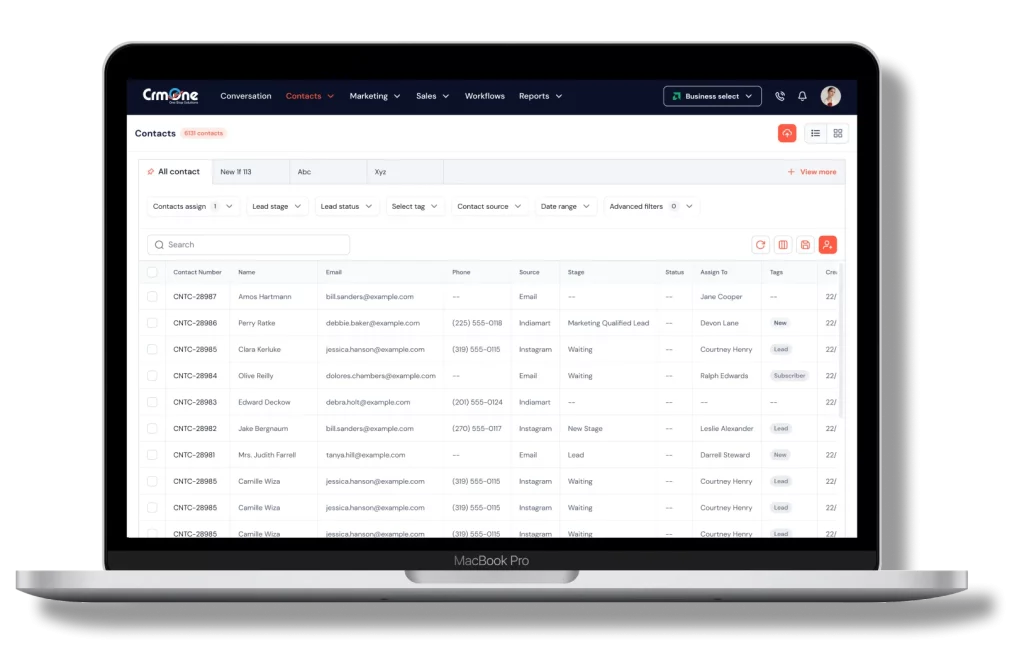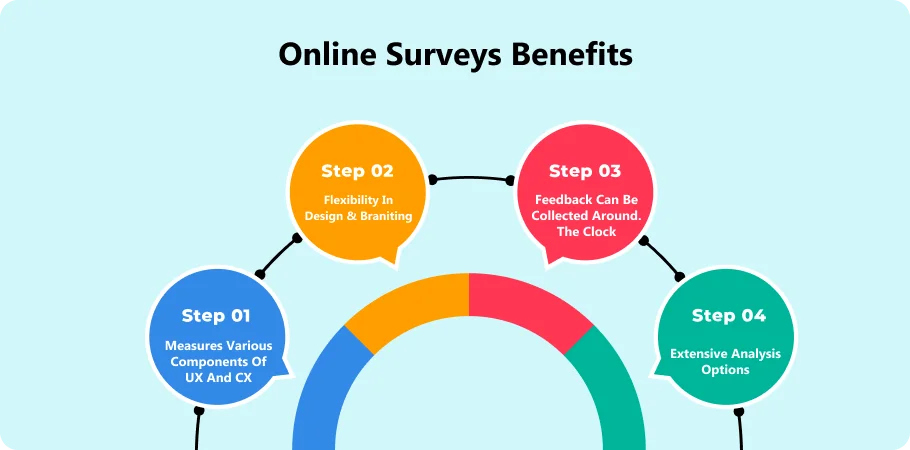In this comprehensive guide, we’ll discuss “How to create an effective Survey: A step-by-step guide” to creating a survey that provides valuable information through online surveys and drives actionable decisions for market research. Creating an effective survey involves more than just assembling a list of questions. It requires carefully considering factors such as question-wording, survey templates, text boxes, and respondent experience. With so many elements to consider, it’s essential to approach survey creation methodically and clearly understand your goals and the public.
This guide will provide practical tips, best practices, and real-world examples to help you in surveys that engage respondents, generate reliable inputs, and ultimately drive informed decision-making. By the end of this guide, you’ll have the knowledge and confidence to create surveys that deliver meaningful information and actionable recommendations. Creating a survey is more than just putting together a bunch of questions; it’s about crafting a tool that gathers valuable information and guides decision-making.
To start, you’ll want to define your survey’s objective clearly. Whether it’s understanding client satisfaction, collecting feedback on a new product, or conducting market research, your objectives will shape the complete questionnaire design process.Once you’ve nailed down your objectives, it’s time to structure your survey. Begin by selecting the correct type of survey templates, questions for your purpose. Multiple-choice questions are great for collecting quantitative data, while open-ended questions allow respondents to provide detailed feedback. Mix and match question types to get a comprehensive view of your topic. Next, pay attention to question wording.
Keep your questions clear, concise, and bias-free to ensure accurate responses. Avoid leading questions that might sway participants one way or another. Additionally, consider the flow of your survey. Start with easy, non-invasive questions answer to warm respondents before diving into more complex topics. This approach helps keep respondents engaged and willing to provide thoughtful answers throughout the survey.
Understanding Survey Creation

Survey creation involves understanding the survey goals, audience, and methodology. Before crafting a survey, you must grasp the fundamental concepts of effective data collection. This includes defining clear research objectives, selecting the appropriate survey tool example, such as Google Forms, and designing an engaging layout. Understanding these factors builds a solid foundation for gathering valuable information that drives business decisions and research goals.
Additionally, considering free tools like Google Forms can provide accessible options for survey creation. Collaboration with your team can further enhance the survey creation process, ensuring diverse perspectives and expertise contribute to its success. Finally, knowing how to create a clear, concise, and relevant survey that fits your objectives is essential for its effectiveness. Survey creation requires balance in generating survey questions and designs systematically to ensure accuracy.
Consideration of factors such as response options, logical order, and the inclusion of a text box to collect information is crucial. By following these steps, you can create a survey-free survey maker that collects information supporting your research objectives. Examples can be included to illustrate key points and to help focus on the research goals. Access to survey tools and resources is essential for creating effective surveys and making surveys. Google Forms, a free tool that is ready to use, is one such platform that provides a user-friendly interface for survey creation.
How to Create Survey

Generating a survey is a powerful method for gathering insights, whether for market research or customer feedback. However, crafting an effective new survey requires more than just asking a few questions. It demands careful planning of how many questions should be included, thoughtful design, and strategic execution. Factors, such as the target audience, objectives, and the most appropriate survey question type are needed to create survey. Include a text box for additional information.
Once these elements are determined, you can make a survey that effectively captures the information you need from your customers. Access to free survey tools and resources ensures anyone can create or make a survey quickly and without financial barriers. Additionally, test the surveys before deployment to ensure their functionality and usability.
From defining your objectives to selecting the free online survey maker and designing multiple-choice type questions, each aspect of creating a survey ensures its success. Employee engagement is crucial for productivity. Setting clear goals ensures that the facts collected drive meaningful change. Providing clear answer options is essential for accurate responses, while analyzing facts or information uncovers invaluable insights to inform decisions.
Steps for an Effective Survey:
Define Your Objectives
Always follow “Keep your customers happy, and they’ll keep you in business”. Defining survey objectives is crucial for effectively obtaining valuable information. It begins by identifying the survey’s purpose, such as assessing customer satisfaction or analyzing market trends. Then, key research questions are determined to address these objectives, ensuring measurability and actionability specifically. Considering the characteristics of the public helps tailor objectives to resonate with them, ensuring relevance.
Aligning survey objectives with broader organizational goals ensures that the findings contribute meaningfully to overarching objectives. Regularly reviewing and refining objectives, along with clearly communicating them, fosters shared understanding and effectively guides the survey creation process. Overall, clear and actionable insights are essential for guiding surveys to gather valuable information and drive meaningful action.
Choose the Right Platform

Choosing the right platform for a survey maker to create a survey is paramount to its success. Consider how you plan to distribute your survey and collect responses, ensuring the survey maker tool provides robust collection and tracking capabilities for real-time monitoring. Integration with other tools and systems and compliance with protection regulations are also essential to safeguard respondent privacy and streamline management processes.
Please take advantage of a free trial or demo version of the survey maker offers to test their features and functionality before committing. By considering features, ease of use, collection options, integration capabilities, security, pricing, and user reviews, you can choose the perfect platform to create a survey that aligns with your objectives and enables you to collect valuable information for informed decision-making.
Survey Questions
Create a survey question which include multiple-choice questions that offer respondents a menu of predefined options. Survey questions is crucial for obtaining valuable insights. Use Google forms and other for the survey. At the same time, open-ended queries prompt free-form responses, delving deeper into respondents’ thoughts and opinions. Prioritize relevance and simplicity to keep respondents engaged and minimize survey fatigue. Pilot test your survey to recognize any ambiguities or issues before distribution, and consider offering incentives to boost participation rates. By carefully designing your survey questions, you can gather meaningful data that informs decision-making and drives success.
Additionally, matrix questions allow survey creators to present a series of questions in a grid format using a survey maker, enabling respondents to provide feedback on multiple related topics efficiently. By strategically formulating multiple questions, survey creators can effectively engage respondents and extract valuable facts that inform decision-making processes.
Determine Your Target Audience

Before conducting survey research, you should have a straightforward research question defining what you want to discover. Based on this question, you must determine who you will target to participate in the survey. Recognize the demographic characteristics of your target audience—age, gender, location, occupation—to tailor your study to their specific needs and preferences. This approach bolsters response rates and enhances data quality.
For example, suppose you’re surveying to gather feedback on a new mobile app designed for fitness enthusiasts. In that case, your focus public might include individuals interested in health and fitness, who own a smartphone, and who are likely to use fitness apps regularly.
Design Your Survey Layout
Designing your survey templates becomes crucial for engaging respondents and maximizing response rates. Aiming for a simple, intuitive layout with clear and consistent formatting ensures a seamless survey experience. Providing answer options that are easy to understand and navigate further enhances respondent engagement.
Prioritizing important information and incorporating visual elements sparingly enhances clarity and reinforces key messages. Breaking up the survey into manageable sections with progress indicators helps respondents track their progress and encourages completion. By following these considerations, you can create a survey layout that improves the respondent experience.
Choose the Right Question Types

The appropriate survey question type is crucial for obtaining the desired information from survey respondents. Common question types include multiple choice question, checkbox for multiple answers, rating scales, Likert scales, open-ended survey questions, and demographic questions. Employing a mix of question types is essential for gathering both quantitative and qualitative data.
For example:
There are two primary forms of survey questions: closed-ended and open-ended.
- Closed-ended survey questions provide respondents with a predetermined set of answers, such as binary answers (e.g., yes/no), scales (e.g., rating scale), or lists of options with single or multiple answer possibilities. These questions are best suited for to create quantitative research based survey, as they yield numerical data that can be statistically analyzed to identify patterns, trends, and correlations.
- On the other hand, open-ended survey questions have no predetermined answers, allowing respondents to answer in their own words. These question formats are ideal for qualitative research, offering insight into respondents’ thoughts and opinions. While open-ended questions are common in interviews, they can also be used effectively in questionnaires, particularly as follow-up questions, to gather more detailed explanations of responses that respondents choose to provide.
Write Clear and Concise Survey Questions
Creating questions that are easily understandable and to the point according to the survey title is essential for effective survey design. Clear and concise questions help respondents provide accurate and relevant answers, leading to better data quality and understanding. Avoiding ambiguity and unnecessary complexity ensures that respondents can quickly grasp the intent of each question and provide meaningful responses. Using straightforward answer choices, avoiding jargon, and keeping survey questions focused on a single topic, you can create a survey that is easy to complete and provides valuable information.
Here’s an example of a clear and concise survey question:
“How satisfied are you with the customer service received during your recent interaction with our company?”
This question is straightforward, focusing on one specific aspect (customer service satisfaction) and providing clear answer options (e.g., very satisfied, satisfied, neutral, dissatisfied, very dissatisfied).
Sequence Your Questions Strategically
Organize your questions logically, ensuring a smooth flow from one topic to the next throughout the entire survey. Commence with easy-to-answer demographic questions to acclimate respondents before delving into more complex or sensitive issues. Avoid abrupt transitions between unrelated subjects to sustain respondent engagement. When crafting your survey title, aim for clarity and relevance to attract participants. Consider utilizing Google Survey tools or other free survey platforms to create great surveys that captivate respondents and minimize the likelihood of survey abandonment.
Here’s an example of strategic question sequencing for a restaurant customer satisfaction survey:
- Start with demographic questions.
- Move to the overall dining experience (ambiance, cleanliness, staff friendliness).
- Transition to food quality, presentation, and taste.
- Inquire about service efficiency (wait times, waitstaff attentiveness).
- Conclude with feedback/suggestions, and a thank you.
Book a CrmOne Demo
Experience the CrmOne simplicity and power. Our experts will show you the best ways to use it and answer your questions in real time. See how CRMOne fits your needs.

Customer satisfaction

Customer satisfaction surveys are research tools used by businesses to gauge their customers’ overall satisfaction with products, services, or experiences. These surveys typically involve questions designed to measure different aspects of the customer experience, such as product quality, customer service, pricing, and overall satisfaction. The information gathered from these surveys helps businesses identify areas for improvement, understand customer preferences, and enhance their services and productivity to better meet customer needs.
Customer satisfaction surveys are vital in maintaining customer loyalty, driving business growth, and fostering positive customer relationships. Ensuring customers are happy and satisfied throughout their customer journey is paramount for businesses seeking to thrive in today’s competitive market.
Creating Surveys
The survey involves crafting questions and designing a layout to gather specific information from respondents. It includes defining objectives, selecting question types, and considering the target public to ensure the survey effectively collects valuable insights. By generating a user-friendly layout and utilizing appropriate online survey platforms, creators can engage respondents and maximize response rates, ultimately achieving their research or business objectives.
Online Survey
An online survey is a data collection method conducted over the internet, where respondents answer to survey questions via digital platforms such as websites, email, or mobile apps free of cost. This method offers convenience for survey creators and participants, allowing easy distribution, faster response times, and cost-effective data collection. Online surveys can range from simple questionnaires to complex research studies, and they are widely used in various fields, including market research, customer feedback, academic research, and employee satisfaction assessments. You can try to create a survey using the free tool.
Online Surveys Benefits

Online surveys have revolutionized how we gather feedback and data. With just a few clicks, businesses, researchers, and organizations can reach a wide public, gather valuable insights, and make informed decisions.
It can be used for various reasons:
Example:
- Customer Feedback: Measure satisfaction and identify areas for improvement.
- Employee Engagement: Assess morale and organizational culture.
- Market Research: Gather data on consumer behavior and preferences.
- Academic Studies: Collect research data across various disciplines.
Test Your Survey

Testing your survey is essential to ensure its functionality, usability, and accuracy before launching it to respondents. Thorough testing can identify any potential issues or errors in the survey layout, question wording, or interactive element functionality. It allows you to make necessary adjustments and refinements to improve the overall survey experience. Additionally, testing helps ensure the survey is compatible across different devices and browsers, maximizing accessibility for all potential respondents.
Testing your survey before deployment is crucial for delivering a seamless and practical survey experience. Before you make a survey live, conducting a comprehensive test is necessary to ensure it functions as intended and captures the desired data accurately.
Set Up Data Collection and Analysis
Configure your survey platform to securely collect and store responses, ensuring the confidentiality and integrity of respondent information. Utilize built-in analysis tools or integrate your survey data with third-party analytics software to uncover deeper trends.
Define key metrics and benchmarks to gauge the effectiveness of your survey. With the help of them, one can measure progress and track performance against predefined goals. By implementing robust management practices and leveraging advanced analytical capabilities, you can derive valuable information that guides decision-making and enhances the overall effectiveness of your survey efforts.
Develop a Distribution Strategy
A meticulous survey distribution strategy is pivotal in effectively reaching your targeted public and maximizing participation. Utilize a multifaceted approach by leveraging various channels such as email, social media platforms, website pop-ups, and paid advertising to enhance exposure and ensure broad reach. Personalize your outreach efforts to relate with your public, increasing the likelihood of higher response rates. Create a strategy to make a survey distribution meticulously; you can optimize engagement and gather valuable insights from your target demographic.
Encourage Participation

Encouraging participation in your survey is crucial for obtaining meaningful insights from your target public. Implement strategies such as clear communication about the purpose of the study and its benefits, offering incentives for participation, and utilizing multiple distribution channels to reach a wider public. Additionally, ensure that the survey is user-friendly and accessible across various devices, and consider sending reminders to non-respondents to increase response rates. By actively promoting participation, you can maximize the quantity and quality of responses, leading to more comprehensive and actionable data.
Monitor Responses in Real-Time
Monitoring survey results in real-time is essential for staying informed and making timely decisions. Choose a survey tool with real-time reporting capabilities and set up alerts for new responses or specific thresholds. Utilize dashboard and visualization tools to track response rates, trends, and patterns as they unfold. Segment and filter facts to gain deeper insights into specific respondent groups. Collaborate with team members to interpret facts and respond promptly to feedback. Continuously monitor survey results to recognize opportunities for improvement and track trends over time.
Analyse Survey Results

Analyzing online surveys is essential for extracting valuable information to guide decision-making. To do this effectively:
- Start by cleaning and organizing the data.
- Recognize key metrics and visualize the information using charts or graphs.
- Conduct descriptive analysis to summarize findings and explore relationships between variables.
Segment the information based on demographics or behaviors to gain a deeper understanding. Interpret the results within the context of your objectives and conclude to inform future actions. Use the findings to improve future survey efforts, ensuring ongoing effectiveness in gathering valuable information.
Conclusion
An effective survey requires meticulous planning, thoughtful design, and strategic execution. Each stage of the process, from defining clear objectives to scrutinizing survey facts, plays a pivotal role in ensuring the success of your online survey maker endeavor and fostering employee engagement.
Creating surveys isn’t a one-size-fits-all task. It requires continual learning, iteration, and adaptation to meet the evolving needs of your audience and objectives. Survey Creator helps in this task By staying updated on best practices, seeking feedback, and embracing opportunities for improvement, you can refine your skills in online survey creation and enhance the impact of your surveys.
Whether you’re an experienced researcher, a business owner seeking feedback of customers , or a student conducting academic research, the principles of effective survey creation remain unwavering. By involving the tips and strategies outlined in this guide in your survey creation process and utilizing survey templates, you can craft surveys that yield valuable information through Google Forms or any other free of cost and drive positive outcomes for your organization or research endeavor. Additionally, addressing factors that may lead to abandon surveys ensures that your efforts produce the desired results.
Get started for Free
Start for free today. Boost your sales by clicking the Get Started button. With CrmOne, you can manage leads, sales, and customer service all in one place.
